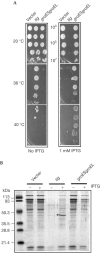In vivo analysis of the overlapping functions of DnaK and trigger factor
- PMID: 14726952
- PMCID: PMC1298978
- DOI: 10.1038/sj.embor.7400067
In vivo analysis of the overlapping functions of DnaK and trigger factor
Abstract
Trigger factor (TF) is a ribosome-bound protein that combines catalysis of peptidyl-prolyl isomerization and chaperone-like activities in Escherichia coli. TF was shown to cooperate with the DnaK (Hsp70) chaperone machinery in the folding of newly synthesized proteins, and the double deletion of the corresponding genes (tig and dnaK) exhibited synthetic lethality. We used a detailed genetic approach to characterize various aspects of this functional cooperation in vivo. Surprisingly, we showed that under specific growth conditions, one can delete both dnaK and tig, indicating that bacterial survival can be maintained in the absence of these two major cytosolic chaperones. The strain lacking both DnaK and TF exhibits a very narrow temperature range of growth and a high level of aggregated proteins when compared to either of the single mutants. We found that, in the absence of DnaK, both the N-terminal ribosome-binding domain and the C-terminal domain of unknown function are essential for TF chaperone activity. In contrast, the central PPIase domain is dispensable. Taken together, our data indicate that under certain conditions, folding of newly synthesized proteins in E. coli is not totally dependent on an interaction with either TF and/or DnaK, and suggest that additional chaperones may be involved in this essential process.
Figures



Similar articles
-
Trigger Factor and DnaK possess overlapping substrate pools and binding specificities.Mol Microbiol. 2003 Mar;47(5):1317-28. doi: 10.1046/j.1365-2958.2003.03370.x. Mol Microbiol. 2003. PMID: 12603737
-
Trigger Factor can antagonize both SecB and DnaK/DnaJ chaperone functions in Escherichia coli.Proc Natl Acad Sci U S A. 2007 Feb 27;104(9):3101-6. doi: 10.1073/pnas.0608232104. Epub 2007 Feb 20. Proc Natl Acad Sci U S A. 2007. PMID: 17360615 Free PMC article.
-
Functional dissection of trigger factor and DnaK: interactions with nascent polypeptides and thermally denatured proteins.Biol Chem. 2001 Aug;382(8):1235-43. doi: 10.1515/BC.2001.154. Biol Chem. 2001. PMID: 11592405
-
Chaperone-assisted protein folding in the cell cytoplasm.Curr Protein Pept Sci. 2001 Sep;2(3):227-44. doi: 10.2174/1389203013381134. Curr Protein Pept Sci. 2001. PMID: 12369934 Review.
-
Interferon-gamma is a target for binding and folding by both Escherichia coli chaperone model systems GroEL/GroES and DnaK/DnaJ/GrpE.Biochimie. 1998 Aug-Sep;80(8-9):729-37. doi: 10.1016/s0300-9084(99)80026-1. Biochimie. 1998. PMID: 9865495 Review.
Cited by
-
A nucleotidyltransferase toxin inhibits growth of Mycobacterium tuberculosis through inactivation of tRNA acceptor stems.Sci Adv. 2020 Jul 29;6(31):eabb6651. doi: 10.1126/sciadv.abb6651. eCollection 2020 Jul. Sci Adv. 2020. PMID: 32923609 Free PMC article.
-
Physiologic effects of forced down-regulation of dnaK and groEL expression in Streptococcus mutans.J Bacteriol. 2007 Mar;189(5):1582-8. doi: 10.1128/JB.01655-06. Epub 2006 Dec 15. J Bacteriol. 2007. PMID: 17172345 Free PMC article.
-
GroES/GroEL and DnaK/DnaJ have distinct roles in stress responses and during cell cycle progression in Caulobacter crescentus.J Bacteriol. 2006 Dec;188(23):8044-53. doi: 10.1128/JB.00824-06. Epub 2006 Sep 15. J Bacteriol. 2006. PMID: 16980445 Free PMC article.
-
The biogenesis of β-lactamase enzymes.Microbiology (Reading). 2022 Aug;168(8):001217. doi: 10.1099/mic.0.001217. Microbiology (Reading). 2022. PMID: 35943884 Free PMC article. Review.
-
Functional conservation and divergence of J-domain-containing ZUO1/ZRF orthologs throughout evolution.Planta. 2014 Jun;239(6):1159-73. doi: 10.1007/s00425-014-2058-6. Planta. 2014. PMID: 24659052 Review.
References
-
- Blattner FR et al. (1997) The complete genome sequence of Escherichia coli K-12. Science 277: 1453–1474 - PubMed
-
- Casadaban MJ (1976) Transposition and fusion of the lac genes to selected promoters in Escherichia coli using bacteriophage lambda and mu. J Mol Biol 104: 541–555 - PubMed
-
- Deuerling E, Schulzespecking A, Tomoyasu T, Mogk A, Bukau B (1999) Trigger factor and DnaK cooperate in folding of newly synthesized proteins. Nature 400: 693–696 - PubMed
Publication types
MeSH terms
Substances
LinkOut - more resources
Full Text Sources
Other Literature Sources
Molecular Biology Databases
Miscellaneous

